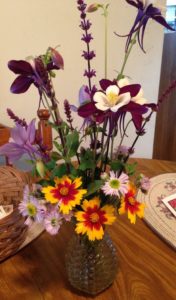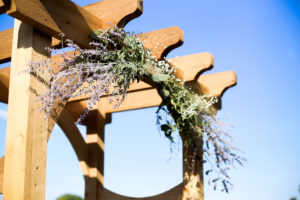Even on cool days, our greenhouse is warm and humid and full of blooming plants! Unfortunately, they are blossoming much too soon to be enjoyed by our FloraKansas shoppers. I have been fastidiously clipping those flowers off in hopes it will boost leaf growth. With all these cut flowers at my disposal, I have been making floral arrangements for all my friends and family. You don’t have to be an artist or a professional florist to make gorgeous, natural looking arrangements with natives. You just have to know what plants to use and a few basic design principles.
Design Basics
On my first cutting of early greenhouse flowers I found some ‘Violet and White’ columbine, ‘Lynnhaven Carpet’ daisy fleabane and ‘Gold and Bronze’ coreopsis. I combined those flowers into a small, columnar arrangement and gave it to my grandma as a surprise. To create fast, no-fuss arrangements on the fly I follow a few simple design principles.
1. Tall elements go in the middle and back, short elements belong in front and sides
2. Use shades/variations of the same color and colors opposite each other on the color wheel
3. Use foliage or thicker blooms at the base of the arrangement as filler to hold things in place
This leaves lots to learn, but if you start with these rules you are sure to get fast, eye-catching results. Serendipitously, this fist cutting was the perfect combination of colors — dark purple columbine, light lilac columbine and daisy fleabane, along with yellow coreopsis, provided that pop of interest that only complementary colors can do so well.
Using Natives with Style
I have had the opportunity to do floral design for many of my close friends’ weddings. Some of them specifically requested the use of native plants, others wanted a touch of native, but mostly traditional choices. I am always amazed at how many beautiful stems, blooms and greenery I can find locally. I pluck these from my yard and the landscapes of friends and family as well as roadsides and pastures (always being careful not to trespass or over-harvest, depleting the future seed bank). By using what is on hand, I am avoiding the costly fresh-cut flower industry and the huge carbon footprint that goes into it. Here are a few examples, in order from ‘least native’ to ‘most native’ material used in the composition.
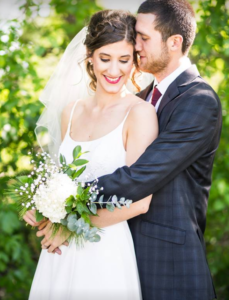
Photo by Moments of Grace Photography
A friend of mine requested only green and white in her bridal bouquet, and wanted something very small and unassuming. I choose store-bought hydrangea blooms and baby’s breath, with varying shades/shapes of greens to keep it interesting – grey, stiff eucalyptus leaves, bright green huckleberry and fresh cut white pine tips, the only locally sourced element seen here. The huge round hydrangea was the centerpiece of the bouquet, so I used tall elements to create a fan effect.
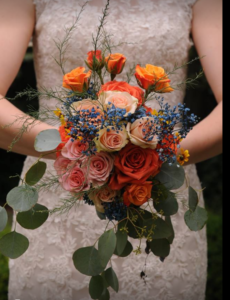
Photo by Miller Studios
This is a bridal bouquet I did for a church wedding. The bride specifically requested something rounded and traditional, but also incorporating her wedding colors (peach and navy blue). I purchased roses, eucalyptus leaves and baby’s breath (which I used floral spray paint to turn blue). In the road side I found dainty yellow blooms of native Coreopsis tinctoria, a perfect complementary splash against blues and greens. I also added some asparagus greenery from an old patch in my parent’s yard – airy and light, it adds nice movement and more green tones without bulking up the bouquet.
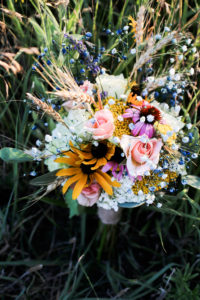
Photo by Rachel Rudeen
In Kansas, summer and fall are great times to get married if you want to incorporate native elements. This particular bride and groom requested wheat heads and lavender as must-haves, along with lots of yellow wildflowers. I bought light pink roses and baby’s breath, but everything else I found in the gardens of their family and friends, making the flowers just that much more meaningful. The Echinacea purpurea, Rudbeckia fulgida and Achillea ‘Sunny Seduction’ were from the grandparents of the groom, as well as the massive white hydrangeas I used at the base for filler.
Beyond the Bouquet
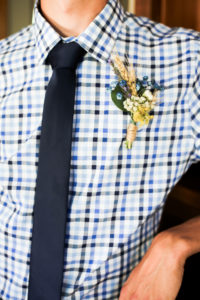
Photo by Rachel Rudeen
I created an alter decoration for that wedding, using fresh Russian sage (Perovskia) from the mother-of-the-bride’s garden and leftover baby’s breath. It smelled amazing and kept its shape even in the drying sun.
Boutineers are a tedious task, but oh so cute! I created an easily reproducible teardrop shape boutineer for the groom, with wheat as a vertical element. To match the bride’s bouquet, I included tiny cuttings of yarrow, lavender and baby’s breath. Knowing that boutineers will need to keep their vigor without water for many hours, flower choice is key – native wild quinine (Parthenium integrifolium) is a white, stiff pearl shaped flower that mimicked the look and shape of the bride’s hydrangeas perfectly, which would have quickly wilted if used in a boutineer.
Winter Wonders
Don’t think the flower power has to end when the growing season does – with strong stems and seed-holding blooms, native plants are excellent specimens for dried arrangements.
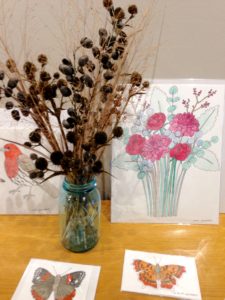
Grasses such as Pancium provide airy but firm filler to work around, and the black, bulbous seed pods of Baptisia australis add interest. This arrangement is complementing the artwork of Leah Gaddert, available for purchase at the Arboretum Visitor Center.
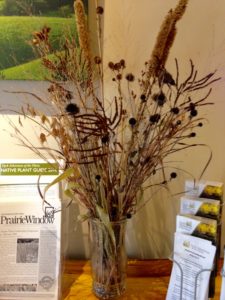
The round seed heads of Eryngium yuccifolium and Echinacea species contrast well with the upright nature of Liatris pycnostachya. Chasmanthium grass (far left in vase), also known as fish-on-a-string, provides a whimsical note.
The best way to always have gorgeous arrangements is to have a great garden to cut them from. By planting native you can feed wildlife and pollinators, as well as your eye for design. Using natives and adaptables in your floral designs is cost effective, has a low-carbon impact and offers new options in every season. Come to the FloraKansas Native Plant Festival and pick up some native plants to get started on your own floral art!

